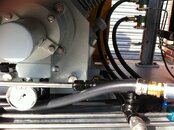I guess you missed the OP's 100 tanks a day part and Tbone's suggestion of running 3 to 4 hours a day.I do not agree with the one big compressor approach. Try to find 2 - each in the 15-20 cfm range.
I also don't recommend trying to be too creative with cheap oils or packing filters. Get something from a supplier that has liability insurance. You cack one tourist with bad air, and you will be forever paying for it. Even in the Bahamas. Test your air regularly.
EP had several Worthington 15cfm compressors a while back, they work well. Check govdeals.com you may find something there.
Hence 40 CFM to kick off.
Next to define bad air. I don't disagree with you but maybe I should have explained it better that with an Industrial oil free breathing air unit you can remove all the filters cartridges and all the chemicals and just run the condensate out the auto dumps for the condensate to drain and for a laugh fill an aluminium cylinder without any filtration and go diving. It proves a valid point albeit the water vapour content is higher than the latest (BS12021) standards require
Further if not convinced the auto condensate tower contains pure distilled water nothing more nothing else once you drain it into a cup and let the dissolved gas clear to a pure clear distilled water you can pour it on your plants, or down any drain or on the beach and you can drink it. It's simply pure distilled water.
Now also agreed you cannot do that with the oil lubricated Coltri or the Bauer and as for the ex Gov deal on the 40 year old Worthington's good luck getting spares or a manual or a parts list.







